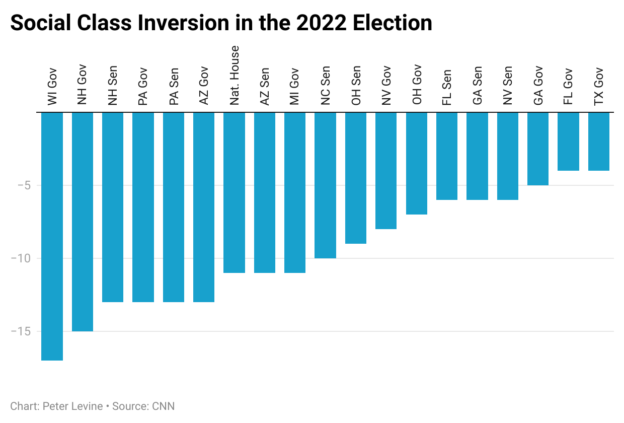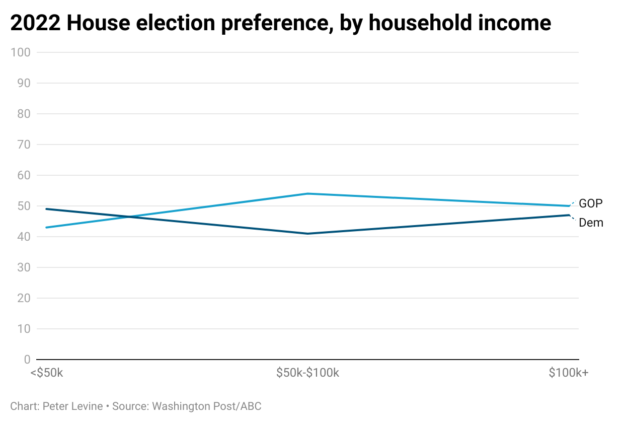One deep story that’s being told about our current political crisis invokes polarization: two “poles” or ends of the spectrum are seen as moving apart and growing mutually hostile. That is a symmetrical metaphor. A different deep story emphasizes the anti-democratic and anti-constitutional turn of MAGA-style Republicans. I would add a third model that involves both parties, but not in a symmetrical way. It is also less about ideas and policies than interests and identities. It’s a story of inverted partisanship.
Envision a democracy with two main parties or coalitions. The left party favors more taxing, spending, and regulation and draws most of its votes from the lower half of the economic scale. The right party opposes government economic intervention and draws its support from the upper half.
This kind of system can be frustrating, since the median voter (who probably comes from the middle of the economic scale) often wields the deciding vote. Both socialist and libertarian principles are somewhat disfavored. However, if you are a socialist or a libertarian, you should believe that you can convince the median voter of your ideas. Meanwhile, the debate is a good one, because citizens can determine the role of government. And both sides are constrained. The left may want lots of government, but as taxes and regulation rise, so will resistance. The right may love markets, but cutting government deeply also creates opposition. The whole system is pretty stable–for better and worse–and it tends to reward ideas that benefit most people.
Now switch the demographics of the parties, so that the rich vote for the left and the poor vote for the right. In that situation, the left will not really do anything substantial to promote equity, because that would cost its affluent voters. You will see lots of virtue-signaling; superficial policies, hypocritically applied; and odd priorities, such as forgiving college debt but not medical debt. Meanwhile, the right will not get far by cutting taxes, since low-income people pay little or no income tax. The right will look for other ways to benefit its constituency, probably including appeals to racial, national, and/or religious identity.
In this situation, the path to ambitious progressive policies is blocked by the left party itself, while the right party is prone to dangerous escalation. You’ll see statements like John Daniel Davidson’s “We Need To Stop Calling Ourselves Conservatives” in The Federalist (Oct 22). Davidson floats adopting a “pro-worker, even pro-union political agenda that once belonged to the left” and displaying “a willingness to embrace government power.” But to what end? “Drag Queen Story Hour should be outlawed,” “parents who take their kids to drag shows should be arrested and charged with child abuse” and “teachers who expose their students to sexually explicit material should not just be fired but be criminally prosecuted.”
Davidson is not a political strategist, and many of his ideas would poll very poorly. In that sense, his own agenda would be constrained by voters. However, partisan political entrepreneurs on the right can develop cannier agendas that win Republican primary elections and legislative majorities in selected states and give them substantial power. They will not arrest parents for attending constitutionally protected public events, but they will arrest Black men for registering to vote in good faith or transport asylum-seekers to Martha’s Vineyard.
I think a model of a class inversion is more informative than one of “polarization,” which assumes that two durable coalitions have moved apart. In contrast, the inversion model presumes that some people have changed their parties–like the Obama-Trump voters of Luzerne County, PA.
There are signs of this class inversion in many democracies today. However, the picture in the USA is mixed, because wealth, race, and education don’t push in the same directions. Right now, according to the Washington Post-ABC poll, household income does not predict people’s opinion of the 2022 election very well. Democrats perform just a touch better among households earning less than $50,000 per year, and Republicans do better above that threshold, but the whole graph (see above) is pretty flat. That’s because income and being white correlate with support for Republicans, whereas education and being black correlate with Democratic support. The result is our somewhat mixed situation, in which the parties fumble between their traditional roles and inverted ones.
I am fully aware that race is at the heart of the issue in the United States–as it has been all along in this country. However, that observation should be the beginning of the conversation, not the conclusion. If the parties invert their class positions because of white racism, then the whole system is in trouble. Socialists, moderates, libertarians, and constitutionalists should all be alarmed. Again, this is not a new threat today; the end of Reconstruction offers a frightening precedent. But it will be a tough trap for our republic to escape.
Real constitutionalist conservatives have critical work to do on their side of the aisle. Meanwhile, Democrats need to win the votes of more low-income whites, whether that means taking Heather McGee’s advice to explain how racial injustice also harms whites, or taking Ruy Teixeira’s advice to reclaim patriotism and certain traditional values, or running campaigns like Tim Ryan’s in Ohio, or simply doing more to benefit low-income communities that include a lot of white voters.
See also the social class inversion as a threat to democracy; social class in the French election; why the white working class must organize etc.

